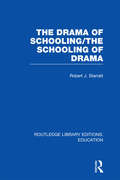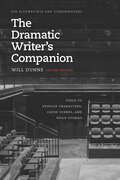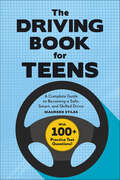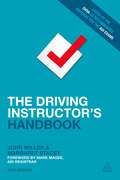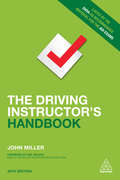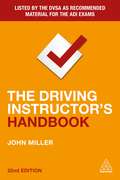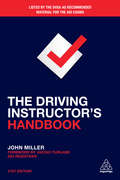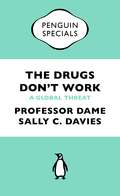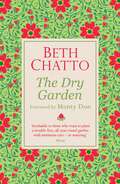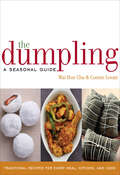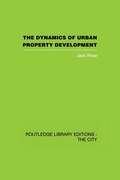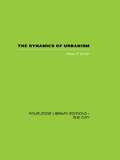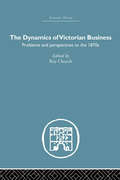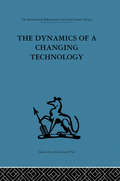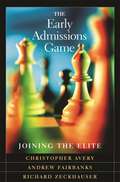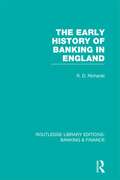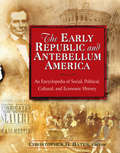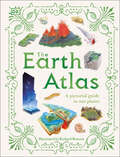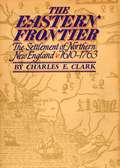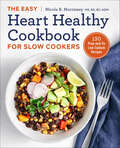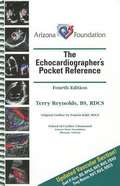- Table View
- List View
The Drama of Schooling: The Schooling of Drama (Routledge Library Editions: Education)
by Robert J StarrattStarratt’s highly original book offers fresh insights into the nature of teaching, learning, schooling as a multi-cultural, social enterprise, and the importance of vision for that leadership—by using the analogy of drama. Schooling is a preparation to participate in the social drama, both as an individual and as a community. Beyond participation, schooling can enable youngsters to maintain and restore the human purposes of the social drama. This unique book accommodates present critics of schools from both the left and the right, but goes beyond them to offer a script for restoring the schools to their human and social purposes.
The Dramatic Writer's Companion: Tools to Develop Characters, Cause Scenes, and Build Stories (Chicago Guides to Writing, Editing, and Publishing)
by Will DunneSpark your creativity, hone your writing, and improve your scripts with the self-contained character, scene, and story exercises found in this classic guide.Having spent decades working with dramatists to refine and expand their existing plays and screenplays, Dunne effortlessly blends condensed dramatic theory with specific action steps—over sixty workshop-tested exercises that can be adapted to virtually any individual writing process and dramatic script. Dunne’s in-depth method is both instinctual and intellectual, allowing writers to discover new actions for their characters and new directions for their stories. The exercises can be used by those just starting the writing process and by those who have scripts already in development. With each exercise rooted in real-life issues from Dunne’s workshops, readers of this companion will find the combined experiences of more than fifteen hundred workshops in a single guide.This second edition is fully aligned with a brand-new companion book, Character, Scene, and Story, which offers forty-two additional activities to help writers more fully develop their scripts. The two books include cross-references between related exercises, though each volume can also stand alone.No ordinary guide to plotting, this handbook centers on the principle that character is key. “The character is not something added to the scene or to the story,” writes Dunne. “Rather, the character is the scene. The character is the story.” With this new edition, Dunne’s remarkable creative method will continue to be the go-to source for anyone hoping to take their story to the stage.“Dunne mixes an artist’s imagination and intuition with a teacher’s knowledge of the craft of dramatic writing.” —May-Brit Akerholt, award-winning dramaturg
The Dream Book: Symbols for Self-Understanding
by Betty BethardsBetty began lecturing and giving seminars on dreams when she realized that "dreams are your greatest tool for understanding yourself and your life." But most people neglect this free inner resource of guidance. "People have been asking me for this book for years," Betty explains, "and at long last here it is. I have channeled information on every symbol in the book, which as you can imagine was a time-consuming task. But I learned so much in the process! Now I gladly share this with you." "Betty's channel is her attunement to her higher self, spiritual guidance or God self. It is a vehicle for receiving insight and information which is usually beyond the reach of the conscious mind. She is quick to point out that everyone has a channel, a level or frequency of awareness called higher consciousness. Attuning to it is really listening to the teacher within or your own guidance. She believes we are particularly receptive to this level in the dream state." This book teaches the reader how to tune into the guidance being communicated through dreams.
The Driving Book for Teens: A Complete Guide to Becoming a Safe, Smart, and Skilled Driver
by Maureen StilesStay safe and smart on the road—a complete driving guide for teens.Learning to drive is an exciting milestone for teens that comes with an amazing sense of freedom and independence—but it's also a big responsibility. Help them be cautious and confident behind the wheel with this ultimate guide to driving for teens.The rules of the road—Make it easy for teens to learn road signs, proper turning and passing etiquette, defensive driving, and more.Acing the test—Teens will find 100 practice questions and an explanation of what their written and driving tests will look like so they can be as prepared as possible.Cars 101—Give your teen an overview on caring for their car—from filling the tank to getting oil changes and knowing what all those lights on the dashboard mean.Safety first—Ensure your teen knows what to do in an emergency or if they are pulled over, how to handle bad weather, and simple ways to avoid distracted driving.If your teen has getting their driver's license on the list for summer activities, pick up this book today and turn them into a savvy driver who's ready for any situation.
The Driving Instructor's Handbook
by John Miller Margaret StaceyNow in its 19th edition, The Driving Instructor's Handbook is widely recognized in the driver training industry as the authoritative reference guide for both trainee and qualified instructors and is listed by the Driver and Vehicle Standards Agency (DVSA) as recommend reading for the Approved Driving Instructor (ADI) exams. This best-selling text covers every aspect of the profession, from the role itself, to the characteristics needed to do the job effectively through the preparation for the three ADI exams (theory and hazard perception, driving ability and instructional ability). It also includes detailed guidance on issues such as licences, training, teaching and coaching skills and road traffic law. This latest edition now also covers practice questions for the ADI part 1 exam, detailed information on driver training, structuring the lesson, dealing with disabilities and impairments and continuing professional development (CPD). The Handbook is essential reading for anyone involved in the training of drivers and instructors at all levels, and will ensure that new drivers are better able to cope with the increasing demands made on them.
The Driving Instructor's Handbook
by John MillerNow in its 20th edition, The Driving Instructor's Handbook is widely recognized in the driver training industry as the authoritative reference guide for both trainee and qualified instructors and is listed by the Driver and Vehicle Standards Agency (DVSA) as recommend reading for the Approved Driving Instructor (ADI) exams. This best-selling text covers every aspect of the profession, from the role itself, to the characteristics needed to do the job effectively through the preparation for the three ADI exams (theory and hazard perception, driving ability and instructional ability). The Driving Instructor's Handbook also includes detailed guidance on issues such as licences, training, teaching and coaching skills and road traffic law and covers all 2016/17 changes to the ADI examinations and standards checks. This handbook is essential reading for anyone involved in the training of drivers and instructors at all levels and will ensure that new drivers are better able to cope with the increasing demands made on them.
The Driving Instructor's Handbook
by John MillerRecognized by the Driver and Vehicle Stands Agency (DVSA) as recommended reading for the Approved Driving Instructor (ADI) exams, this bestselling guide is the authoritative guide for both trainee and qualified driving instructors. The Driving Instructor's Handbook covers every aspect of being a driving instructor, from the role itself, to the characteristics needed to the job effectively, through to preparation for the ADI exams. Now in its 22nd edition, the book includes detailed guidance on issues such as licences, training, teaching and coaching skills and road traffic law. Fully updated to cover all changes including updates to the ADI theory and practical tests, new rules in the Highway Code, revised motorway legislation, different rules and procedures in Northern Ireland and updated advice on disabilities, this book is essential reading for anyone involved in the training of drivers or driving instructors.
The Driving Instructor's Handbook: A Reference And Training Manual
by John MillerNow in its 21st edition, The Driving Instructor's Handbook is widely recognized in the driver training industry as the authoritative reference guide for both trainee and qualified instructors and is listed by the Driver and Vehicle Standards Agency (DVSA) as recommended reading for the Approved Driving Instructor (ADI) exams.This best-selling text covers every aspect of the profession, from the role itself, to the characteristics needed to do the job effectively through the preparation for the three ADI exams (theory and hazard perception, driving ability and instructional ability). The Driving Instructor's Handbook also includes detailed guidance on issues such as licences, training, teaching and coaching skills and road traffic law and covers all 2016/17 changes to the ADI examinations and standards checks, including the most recent essential updates from late 2017. This handbook is essential reading for anyone involved in the training of drivers and instructors at all levels and will ensure that new drivers are better able to cope with the increasing demands made on them.
The Drugs Don't Work: A Global Threat (Penguin Specials)
by Professor Dame Davies Dr Jonathan Grant Mike CatchpoleThe Drugs Don't Work - A Penguin Special by Professor Dame Sally Davies, the Chief Medical Officer for England'If we fail to act, we are looking at an almost unthinkable scenario where antibiotics no longer work and we are cast back into the dark ages of medicine where treatable infections and injuries will kill once again' David Cameron, Prime MinisterResistance to our current range of antibiotics is the new inconvenient truth. If we don't act now, we risk the health of our parents, our children and our grandchildren.Antibiotics add, on average, twenty years to our lives. For over seventy years, since the manufacture of penicillin in 1943, we have survived extraordinary operations and life-threatening infections. We are so familiar with these wonder drugs that we take them for granted. The truth is that we have been abusing them: as patients, as doctors, as travellers, in our food.No new class of antibacterial has been discovered for twenty six years and the bugs are fighting back. If we do not take responsibility now, in a few decades we may start dying from the most commonplace of operations and ailments that can today be treated easily.This short book, which will be enjoyed by readers of An Inconvenient Truth by Al Gore and Bad Pharma by Ben Goldacre, will be the subject of a TEDex talk given by Professor Dame Sally Davies at the Royal Albert Hall.Professor Dame Sally C. Davies is the Chief Medical Officer for England and the first woman to hold the post. As CMO she is the independent advisor to the Government on medical matters with particular interest in Public Health and Research. She holds a number of international advisory positions and is an Emeritus Professor at Imperial College.Dr Jonathan Grant is a Principal Research Fellow and former President at RAND Europe, a not-for-profit public policy research institute. His main research interests are on health R&D policy and the use of research and evidence in policymaking. He was formerly Head of Policy at The Wellcome Trust. He received his PhD from the Faculty of Medicine, University of London, and his B.Sc. (Econ) from the London School of Economics.Professor Mike Catchpole is an internationally recognized expert in infectious diseases and the Director of Infectious Disease Surveillance and Control at Public Health England. He has coordinated many national infectious disease outbreak investigations and is an advisor to the European Centre for Disease Prevention and Control. He is also a visiting professor at Imperial College.
The Dry Garden
by Beth Chatto'I return to Beth Chatto's books constantly. For those who are new to her work, you are entering into a life-long relationship with a wise friend and gardener' Monty Don'Invaluable to those who want to plant a trouble-free, all-year-round garden with minimum care - or watering' FLORAIn today's climate of increasingly hot summers and dry winters, gardeners need guidance on plants that will thrive in dry conditions. In Beth Chatto's classic book, she uses plants that need very little attention and are naturally adapted to flourish in dry conditions to provide a year-round display of beautiful foliage and flowers. Drawing from her own immense experience, she provides valuable guidance on types of soil and on basic principles of design. She discusses the plants and plantings suited to dry conditions and includes a detailed list of plants, with notes and advice on their characteristics.
The Dumpling: A Seasonal Guide
by Connie Lovatt Wai Hon Chu“A global perspective on dumplings. . . . Cooks at all levels will delight in this book as they try their hands at familiar favorites as well as new dishes.” —Publishers WeeklyThe Dumpling is the most comprehensive and wide-ranging anthology of traditional recipes available for those who love dumplings in every shape, size, and variety. Wai Hon Chu—who has worked in the kitchens of March, Clementine, and The Russian Tea Room, and is creator of El Eden Chocolates, named Best Gourmet Chocolate by New York Press—and personal chef Connie Lovett take dumpling aficionados on a culinary tour around the globe, offering more than 100 mouthwatering recipes that cover the full range of dumpling possibilities. “A fine new book...richly instructional. So . . . study up, fling open your door and step out to sample this delightful, richly varied fare. Or stay at home, prop up your copy of The Dumpling, invite in a few friends and go traveling in your own kitchen.” —Nach Waxman, owner of Kitchen Arts & Letters
The Dutch World of Washington Irving: Knickerbocker's History of New York and the Hudson Valley Folktales (New Netherland Institute Studies)
by Elisabeth Paling FunkThe Dutch World of Washington Irving tells an alternative origin story of American literary culture. In December of 1809, before finding fame with "Rip Van Winkle" and "The Legend of Sleepy Hollow," Washington Irving published his satirical A History of New York, from the Beginning of the World to the End of the Dutch Dynasty under the pseudonym Diedrich Knickerbocker. Elisabeth Paling Funk explains that the History of New York and the Hudson Valley folktales that followed were part of an early trend of responding to the national desire for a historical record. Funk argues that these works uniquely describe this part of the American scene in the period of the Early Republic and bring forward the Dutch strain in its history and culture.Funk explores what the young Irving would have read, heard, and observed during his early life and career in New York City, once part of the former colony of New Netherland, where he was surrounded by Dutch-speaking neighbors and relatives and Dutch literature. Based on these sources, The Dutch World of Washington Irving argues that Irving's Knickerbocker works—not only his History but also his Hudson Valley stories—represent a crucial effort to preserve Dutch life and folk customs in the Hudson Valley in the face of Anglo-Americanization. Providing the first complete glossary of Irving's Dutch vocabulary and drawing on untranslated Dutch sources, Funk offers cultural historians, scholars of American folklore and literature, and the latest generation of Irving's readers unprecedented access into the Dutch world of Washington Irving and his American contemporaries.
The Dynamics of Urban Property Development
by Jack RoseJack Rose examines the social, economic and political forces which have shaped the towns and cities of the UK since the Industrial Revolution. The unrestricted and largely unplanned development which followed the Industrial Revolution created unacceptable living and working conditions for which a century of legislation failed to provide a remedy. In the last fifty years of economic, political and legal changes have all affected the shape and speed of development through rent control, taxation, planning directives and other mechanisms. The interplay of political changes and economic circumstances which produces the 'dynamics' of development is covered here from the unique standpoint of the author's long and successful career in the property industry. This book was first published in 1985
The Dynamics of Urbanism
by Peter F. SmithRoutledge Library Editions: The City reprints some of the most important works in urban studies published in the last century. For further information on this collection please email info.research@routledge.co.uk.
The Dynamics of Victorian Business: Problems And Perspectives To The 1870's
by Roy ChurchFirst Published in 2005. Routledge is an imprint of Taylor & Francis, an informa company.
The Dynamics of a Changing Technology: A case study in textile manufacturing
by Peter J Fensham Dougles HooperTavistock Press was established as a co-operative venture between the Tavistock Institute and Routledge & Kegan Paul (RKP) in the 1950s to produce a series of major contributions across the social sciences. This volume is part of a 2001 reissue of a selection of those important works which have since gone out of print, or are difficult to locate. Published by Routledge, 112 volumes in total are being brought together under the name The International Behavioural and Social Sciences Library: Classics from the Tavistock Press. Reproduced here in facsimile, this volume was originally published in 1964 and is available individually. The collection is also available in a number of themed mini-sets of between 5 and 13 volumes, or as a complete collection.
The Dyslexia Handbook: Procedures Concerning Dyslexia and Related Disorders (Revised #2014)
by The Editors at the Texas Education AgencyThe handbook contains the SBOE-approved procedures concerning dyslexia and related disorders.It also provides guidelines for school districts to follow as they identify and provide services for students with dyslexia.
The Early Admissions Game: Joining The Elite, With A New Chapter
by Richard J. Zeckhauser Christopher. Avery Andrew. FairbanksEach year, hundreds of thousands of high school seniors compete in a game they'll play only once, whose rules they do not fully understand, yet whose consequences are enormous. The game is college admissions, and applying early to an elite school is one way to win. But the early admissions process is enigmatic and flawed. It can easily lead students toward hasty or misinformed decisions. This book--based on the careful examination of more than 500,000 college applications to fourteen elite colleges, and hundreds of interviews with students, counselors, and admissions officers--provides an extraordinarily thorough analysis of early admissions. In clear language it details the advantages and pitfalls of applying early as it provides a map for students and parents to navigate the process. Unlike college admissions guides, The Early Admissions Game reveals the realities of early applications, how they work and what effects they have. The authors frankly assess early applications. Applying early is not for everyone, but it will improve--sometimes double, even triple--the chances of being admitted to a prestigious college. An early decision program can greatly enhance a college's reputation by skewing statistics, such as selectivity, average SAT scores, or percentage of admitted applicants who matriculate. But these gains come at the expense of distorting applicants' decisions and providing disparate treatment of students who apply early and regular admissions. The system, in short, is unfair, and the authors make recommendations for improvement. The Early Admissions Game is sure to be the definitive work on the subject. It is must reading for admissions officers, guidance counselors, and high school seniors and their parents.Table of Contents: Introduction: Joining the Game 1. The History of Early Admissions 2. The State of the Game 3. Martian Blackjack: What Do Applicants Understand about Early Admissions? 4. The Innocents Abroad: The Admissions Voyage 5. The Truth about Early Applications 6. The Game Revealed: Strategies of Colleges, Counselors, and Applicants 7. Advice to Applicants Conclusion: The Essence of the Game and Some Possible Reforms Appendix A: Median SAT-1 Scores and Early Application Programs at Various Colleges Appendix B: Data Sources Appendix C: Interview Formats Acknowledgments Tables and Figures Index Reviews of this book: Applying to an elite college through an early-admissions program can improve students' chances of getting in by as much as 50 percent over their odds during the regular admissions cycle, a difference that is the equivalent of scoring 100 points higher on the SAT...Based on an analysis of admission data at top colleges, as well as interviews with over 400 college freshmen [The Early Admissions Game] challenges the official line of college admissions deans, who have long held that applying early does not give prospective students an advantage over regular applicants. But the research confirms what many high-school counselors already suspected, and it is likely to fuel debate over whether early-admissions programs favor wealthy and well-connected students and should be eliminated or reformed.--Jeffrey R. Young, Chronicle of Higher EducationReviews of this book: [This] important contribution to the college-admissions process should reduce the general anxiety that pervades today's transition to college and, in particular, help level the playing field for students who lack access to adequate college counseling. The book may also prompt needed reform of contemporary admissions practices...The authors' goal...deserves acclaim for helping inner-city and rural students and those in other understaffed districts to pursue admission on a much more even footing...There is a wealth of information in this well-organized, clearly-written book which will enable students to make better college choices.--William R. Fitzsimmons, Harva
The Early History of Banking in England (Routledge Library Editions: Banking & Finance)
by Richard D RichardsThis is widely acknowledged as a scholarly and well-documented study of early banking in England. It bridges gaps in the early history of English banking and deals with the operations of the pre-Bank of England bankers, the evolution of English paper money and the remarkable transactions of the early directors of the Bank of England. Although the main body of the book concentrates on the 16th and 17th centuries, the volume includes a brief survey of English banking in the 18th and early 19th centuries.
The Early Republic and Antebellum America: An Encyclopedia of Social, Political, Cultural, and Economic History
by Christopher G. BatesFirst Published in 2015. This text holds four volumes of essays and entries on the early Republic and Antebellum era in America spanning the end of the American Revolution in 1781 to the outbreak of Civil War in 1861. The Americans forged a new government in theory and then in practice, with the beginnings of industrialisation and the effects of urbanisation, widespread poverty, labour strife, debates around slavery and sectional discord. By the end of the nineteenth century American had a powerhouse economy, new technologies and the emergence of major social reform movements, creation of uniquely American art and literature and the conquest of the West. This encyclopaedia offers a historic reference.
The Earth Atlas
by DKDelve beneath the surface of Earth with this pictorial atlas and discover the secrets of our planet.How did planet Earth form? What&’s under the surface, and how can we see it? Why do volcanoes erupt? What do coasts and caves have in common? What&’s so important about rocks and soil? If you find yourself seeking the answers to these questions and more, then this may be the book for you!Introducing The Earth Atlas – a lavishly illustrated guide to our planet. From oceans to ice regions to deserts, this book takes you on an exciting trip to discover more about the Earth&’s features, explaining how they formed and what impact they have on us even today, supporting life and shaping the world with every tectonic movement!Ready for an adventure? Dive straight in to discover: - A strikingly visual guide to the innermost depths of our Earth- Exquisite hand-drawn illustrations and maps making the information engaging and accessible- A diverse range of fascinating information using captions and detailed cross sectionsFrom ferocious volcanoes to testing tornadoes, The Earth Atlas is an engaging, fact-packed, and educational book for children aged 9–12, especially those interested in natural science, geology, geography, or ecology. So whether you&’re a budding young geographer, or a teacher looking for an engaging resource to use in your classroom, this earth encyclopedia is full of fascinating facts that are sure to delight young readers time and time again. At DK, we believe in the power of discovery. So why stop there? If you like The Earth Atlas, then why not complete the collection? Take a peek inside the beautiful and absorbing world of birds with The Bird Atlas, explore the awe-inspiring animal kingdom with The Animal Atlas and reveal the inner workings of the human body with The Body Atlas. Whatever your preferred topic, this fact-packed and fun series from DK is sure to delight!
The Eastern Frontier: The Settlement Of Northern New England, 1610-1763
by Charles ClarkThis extremely readable account of early New England settlements emphasizes the development of a distinctive culture derived from the varied groups that settled there.
The Easy Heart Healthy Cookbook for Slow Cookers: 130 Prep-and-Go Low-Sodium Recipes
by Nicole R. MorrisseyThe Easy Heart Healthy Cookbook for Slow Cookers offers the fastest prep-and-go recipes for low-sodium meals.To maintain a low-sodium diet, you need a heart healthy cookbook with recipes that are simple, quick, and convenient to fit into your everyday routine. The Easy Heart Healthy Cookbook for Slow Cookers makes low-sodium meals easier than ever with prep-and-go recipes for your slow cooker. Prep meals in 15 minutes or less—with no additional steps—and discover how simple it is to fit low-sodium meals into your schedule.Prep, set, and forget about extra steps with this heart healthy cookbook. The Easy Heart Healthy Cookbook for Slow Cookers provides a simple solution to low-sodium meals with:130 Easy Slow Cooker Recipes that prep in 15 minutes or less and require no pre-cooking or further stepsAn Overview of Heart Health that teaches you how to maintain a healthy lifestyle through diet and exerciseA Slow Cooker Guide that lists pantry essentials, Dos and Don'ts, plus tips on how to best use your slow cooker for this heart healthy cookbookWhen time is the only ingredient you're missing, prep low-sodium meals fast with The Easy Heart Healthy Cookbook for Slow Cookers.
The Eat-a-Bug Cookbook, Revised
by David George GordonWith its stylish new package, updated information on the health and environmental benefits of insect eating, and breed-your-own instructions, this new edition of The Eat-a-Bug Cookbook is the go-to resource for anyone interested in becoming an entomological epicure.For many Americans, eating a lowly insect is something you'd only do on a dare. But with naturalist and noted bug chef David George Gordon, bug-eating is fun, exciting, and downright delicious! Now you can impress, enlighten, and entertain your family and friends with Gordon's one-of-a-kind recipes. Spice things up at the next neighborhood potluck with a big bowl of Orthopteran Orzo--pasta salad with a cricket-y twist. Conquer your fear of spiders with a Deep-Fried Tarantula. And for dessert, why not try a White Chocolate and Wax Worm Cookie? (They're so tasty, the kids will be begging for seconds!) Today, there are more reasons than ever before to explore entomophagy (that's bug-eating, by the way). It's an environmentally-friendly source of protein: Research shows that bug farming reduces greenhouse gas emissions and is exponentially more water-efficient than farming for beef, chicken, or pigs. Mail-order bugs are readily available online--but if you're more of a DIY-type, The Eat-A-Bug Cookbook includes plenty of tips for sustainably harvesting or raising your own. Filled with anecdotes, insights, and practical how-tos, The Eat-A-Bug Cookbook is a perfect primer for anyone interested in becoming an entomological epicure.
The Echocardiographer's Pocket Reference
by Terry Reynolds Pamela KiddI would first wish to express my deep gratitude to each of you for your continued support of this book. The fourth edition provides the newest American Society of Echocardiography recommendations for valvular stenosis
